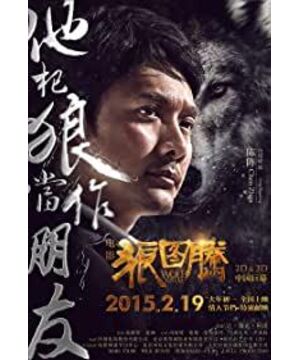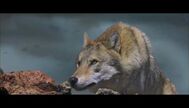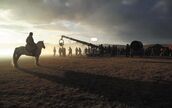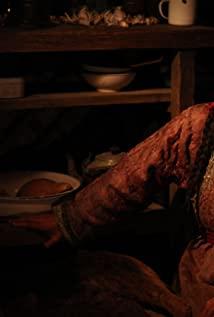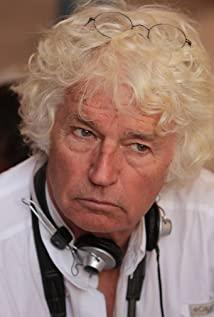In modern times, it is even more difficult to write only one successful book in a lifetime. After becoming famous, the drive of interest and the pressure of the publisher will make the writer continue to create. A person who really eats a fresh book all over the sky can't survive unless it is in the south of the Yangtze River. For example, the world tyrant sings in "Ghost Blowing the Lamp", that is, he pours all his passion and life experience into one book, just like "Wolf Blowing Lamp". Jiang Rong, the author of Totem.
At the end of the original novel, the following sentence is written: The draft was written in the eastern Ujimqin grassland of Ximeng, Inner Mongolia in 1971, and the draft was finalized in Beijing at the end of 2003. From here, we can clearly see that, as a person from that era full of red passions and dreams, Jiang Rong has turned all his life memories, era insights and values into such a book, so that more People saw the auspicious film feathers of that era. The most special feature of this novel is that it stands on an almost unprecedented angle, allowing us to have the opportunity to examine the people in the north that are both our enemies and friends. Such efforts and achievements should be worthy of recognition.
However, whether it was when the novel came out ten years ago, or after the film was released today, there was a lot of criticism. Interestingly, this sound comes from two sides. Han nationalists denounced the author for beautifying aliens and downplaying historical crimes, but as the one who spared no effort to praise the book, some Mongolian scholars accuse the author of being ignorant of national culture and wearing the "totem" hat by mistake.
From what I understand, the myths and legends of the Mongolian nation start with "blue wolf and white deer", so at least the wolf should be one of the Mongolian totems. Although the totem worship of the Mongolians is diverse, as the king of the grasslands, as the animal most worshipped and best at imitating by the Mongolian ancestors, the wolf should still be the most important totem of the Mongolians.
Of course, you can say that the Mongols "hate" more than "revere" wolves. Because wolves not only eat sheep, but also threaten people's lives in disaster years. But isn't this kind of reverence just as human beings are towards nature, as the Mongolians are towards their longevity Tengger? Ancient people, how could there be no love for nature and all animals for no reason, or hatred for no reason? What can be eaten and available is naturally love. Dangerous and terrible, it is inevitable that hatred will lead to respect, and even some kind of supernatural identity and status. The sky and the earth are cracking, and the raptors and beasts are no exception.
From this point of view, it seems quite reasonable to say that the Mongols, or more generally, all nomadic peoples use wolves as "totems".
Turning his head, he looked at the various criticisms of the "Wolf Totem" by the Han people.
The most criticized part of this book is the "blood transfusion theory" put forward by the author Jiang Rong - he regards the invasion of the Central Plains by the historical nomads again and again as a way for us, an old, introverted nation, to gain new vitality again and again. blood transfusion" process. This undoubtedly evoked the pain of the big Han nationalists' scars. How can you deserve such a reputation for humiliating and seeking peace, lowering your body time and time again, and even donating blood?
In fact, if the tragic nature of the process is ignored, this argument has its own solid foundation. The collision of cultures and the fusion of nations, and even the war itself, will bring new vitality to a civilization, which is an accepted law in history. Although the civilization of the nomads is too primitive compared to the Han people, it has brought a different object of observation to the Han culture after all. The Arab and even Roman civilizations, which are comparable to the Han civilization, were introduced into the Central Plains dynasties through nomadic peoples.
Finally, what some people criticize is the worship of the "wolf nature" in the original work. After reading the novel, German sinologist Kubin said directly: ""Wolf Totem" is fascism, this book shames China."
But wait, if you collect enough opinions, you will find that this book is the most popular The place is also due to this "wolf nature". Zhang Ruimin, CEO of Haier Group, appreciates this book, and compares the ecological competition on the grasslands in the book to real market competition. Obviously, he hopes that Haier Group will become the pack of wolves on the grasslands.
This description of "wolf nature" is easily reminiscent of another world famous book "The Call of the Wild". Although one is a wolf and the other is a dog, their cores are quite similar. The reason why this novel by Jack-London became popular is not unrelated to the gold rush in the United States and the adventurous and unrestrained spirit of the American character. And the same kind of wildness has become an unwelcome thing in China. Why?
Perhaps, this is due to the servility of our Han people.
Compared with the bloody nature of the nomadic "wolf", the Han people do have a "slavery" like a sheep. This may be the natural cowardice in the blood of the farming nation, or it may be the survival wisdom that has been repeatedly trained under the iron cavalry of foreign races. All in all, the great wisdom of the sages has gradually evolved into the small cleverness of Ah Q, and the iron bones of the pre-Qin period and even the Han and Tang Dynasties have gradually become a group of insensitive people.
Thinking about it carefully, it seems that the various inferiorities of the Han nationality are exactly the opposite of the "wolf" animal, or the various advantages of the "wolf nature" can just make up for the various deficiencies of our nation. The fighting spirit and bloody nature need not be said. The Han people are fond of infighting. The wolf is one of the best large animals for teamwork.
This brings up another topic. If Jiang Rong's so-called "blood transfusion theory" is established, then why is the Han nationality lacking the most essential thing that these nomadic people have learned from wolves? It can only be blamed that the Tao of Confucius and Mencius brought the Chinese people too deep an ethical foundation, thus automatically excluding all values inconsistent with it.
Just like now, many people, whether they are watching the original book or watching a movie, carry a value and ideological "correctness" in advance to criticize those different value orientations, but lack an inclusive heart to examine Different beauty and power.
Perhaps because of concerns about this controversy, or perhaps for the sake of simplification, the values and themes that end up in the film are quite different from the original. The wolf nature and survival competition gave way to human beings and nature, and the tone full of national characteristics and cultural conflicts became the universal value of environmental protection. This ultra-luxurious screenwriting troupe, including two Oscar-level gold-medal screenwriters, director Arnold himself, and China's first screenwriter Lu Wei, finally handed over an unbelievably decent homework.
It is said that the film party recruited Jean-Jacques Arnold to bring a "French" romance to the film. The old man may indeed be the director who is best at filming animals in the world. His "Tiger Brother Tiger Brother" and "Zi Xiong Tale" are both classic works with very high appreciation. However, as a Frenchman, he neither knew enough about the special history of China, nor did he study deeply the contradictions and integration of nomadic peoples and farming civilization. In addition, he did not know whether he deliberately avoided or unintentionally ignored ideology and other issues. The film fell into a kind of spectacle-like fragmentation, and the fluency and integrity of the narrative were also compromised on the basis that the original book itself was not strong. Similarly, he did not pay enough attention to the role of "people" in the film, especially his understanding of the relationship between Mongolians and wolves fell into overutilization, making the whole film almost a one-man show for "wolf stars".
So the biggest success of this film is attributed to the animal trainer Andrew Simpson. It is said that the best wolf trainer in the world accepted the job very readily when he received a call from the crew, and joked: I had known for a long time that I would receive this job. After reading the original novel , I've been waiting for this call for years.
Simpson spent three years domesticating three generations of "wolf stars", and finally achieved incredible results. The acting skills of the animal stars are comparable to that of movie stars. They have both the realism and shock like a DISCOVERY documentary, and there is no lack of detailed expression comparable to CG special effects. Go through "immigration procedures" for them and bring them back to Canada.
Indeed, every wolf that appears in the film has a charming charm, plus the magnificent scenery of the Mongolian grasslands and the sonorous male soundtrack with ethnic customs, all add great visibility to the film. Especially as the climax of the play, the "Wolf and Horse Wars" section captures a soul-stirring epic sense and a majestic natural vitality. However, after all, this is not a documentary about the wolf clan. It is simply reduced to the theme of environmental protection, and it is also a bit of a waste. The real essence of the original work is beyond recognition in the director's drastic deletion.
There are only two places where the director still retains his unique perspective and humanistic care, showing a more profound and complex theme. At the end of the article, I would like to discuss this a little bit.
One is the question of faith. Needless to say, the Han Chinese lacked beliefs. The Mongolian beliefs were actually mixed with the chaos of primitive shamanism and Tibetan Buddhism. But no matter what form it takes, it's never a bad thing to have the most basic respect for "heaven".
This film does not discuss this issue in depth, and only uses a few strokes to outline it. The first is the words of Papa Billig: Don't let our God be your slave. This is not just a question of totem beliefs, but more of a primitive and wild way of life, the worry of being eroded by modern civilization and dying out. Secondly, it is the Mongolian tradition of sky burial. In this film, the religious meaning of celestial burial is not comparable to that of Lu Chuan's "Kekexili", and more expresses a primitive environmental protection concept of "the body gives back to nature". In the end, the director used two clouds to form the picture - Changshengtian and wolf, which not only implies the "wolf totem" and the gods to a certain extent, but also the "God's will" that is higher than all personal wills. , expressed visually in a romantic way.
Maybe my understanding is superficial, but I still have the feeling that the Mongols' reverence for Changshengtian is a spiritual force, but it is also pragmatic. No matter good or bad, as long as the name of Tengger is used, it seems to have moral rationality. Although the little wolves who fell to their death and waited for their breasts were helpless, they were cruel and ruthless, but as long as they told themselves that they were just returning to the embrace of the immortal heaven, it seemed that they had explained to themselves and their children, and their hearts would be at ease. If you open your mind a little bigger, think of the crusades in history, the sectarian wars in modern Islamic society, religion, religion, how many crimes in your name?
The second is the shocking death of the last two coyotes. Whether it is a wolf that collapsed and committed suicide in a cave, or a wolf that died of exhaustion after a long run, it is the most perfect embodiment of a "wolf nature". Even, you can easily think of the spirit of Bushido, which is unyielding, unforgiving, neither humble nor arrogant. The director used a strong stroke to fill the film's downplaying of the "wolf nature" hymn to the extreme at one time, and this tragic "anti-climax" was arranged before the ending, which added to the film's tragic color. This is the end of the "wolf", the era of the end of the prairie hero. Just like Akira Kurosawa's "Seven Samurai", even the victors are only the losers, because the larger and irreversible historical torrent gradually swept their values and way of life into a corner only for memory.
In the process of modernization, globalization and industrialization, the nomadic lifestyle and wolf heroism will eventually disappear, but the wolf totem should not be forgotten.
Because, no matter when, we always live on a grassland, eat, or be eaten.
As for the war on the grassland, the result is already doomed. The only variable is whether you are a wolf or a sheep.
View more about Wolf Totem reviews


